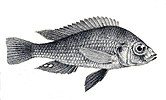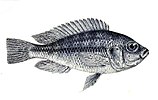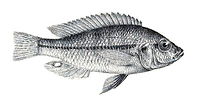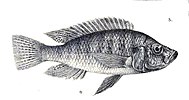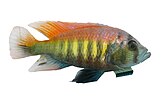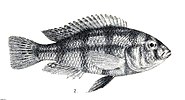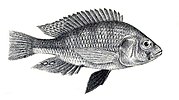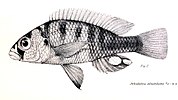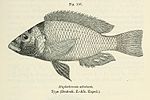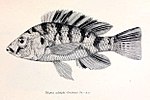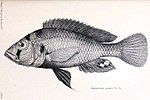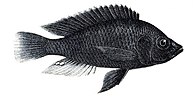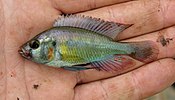Haplochromis
| Haplochromis | ||||||||||||
|---|---|---|---|---|---|---|---|---|---|---|---|---|
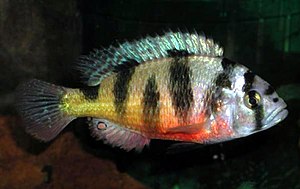
Haplochromis latifasciatus from Lake Kyoga . |
||||||||||||
| Systematics | ||||||||||||
|
||||||||||||
| Scientific name | ||||||||||||
| Haplochromis | ||||||||||||
| Hilgendorf , 1888 |
Haplochromis ( Gr . Haplos = simple, Chromis = genus of damselfish, in which cichlids were previously described) is thelargest genus of cichlids (Cichlidae)with over 200 scientifically described species . They live in South and East Africa, mainly in the area of the Great Rift Valley , the mainarea ofdistribution is Lake Victoria and its tributaries. Many Haplochromis species of Lake Victoria areendangered, threatened with extinction or even extinctby the Nile perch ( Lates niloticus )introduced by humans.
features
Haplochromis species are 7 to 27 centimeters long, their tail fin ends straight cut, rounded or slightly indented. Male Haplochromis in courtship mood are intensely colored, sometimes very brightly colored and thus differ significantly from the mostly gray or brown colored females. In the anal fin the males have egg spots, which are surrounded by a transparent border. In the female animals, the eggspots are smaller, their number is smaller, they can also be absent. The transparent border is always missing.
The Haplochromis, some of which are called Furu in Kenya , Mbipi in Tanzania and Enkejje or Oroy in Uganda, and closely related genera of the Lake Victoria catchment, developed different mouth shapes and tooth types and thus adapted to different food sources. There are up to 15 different trophic groups:
- Fish-eaters (piscivores) that eat whole, adult fish and not just parts (scales, fins) or eggs and larvae (pedophages)
- Algae eater (differentiation between algae grass and phytoplankton eater )
- Leaf eater (herbivore)
- Insectivore (Insectivore)
- Fry eater (pedophages)
- Snail eater (differentiation between snail crackers and snail peelers)
- Zooplankton eater (zooplanctivore)
- Crustacean eater (differentiation between shrimp and crab eater)
- Sludge sieve (detritivore)
- Parasite eater ( cleaner fish )
- Scale eater
- Fin bite
Reproduction
All Haplochromis species are mouthbrooders . The males are polygamous . Before mating, the male often prepares a pit in the bottom of the water as a spawning place. With fluttering movements, in which especially the anal fin provided with the egg spots is presented, it advertises the female. During and immediately after spawning, the female takes the eggs into her mouth, sometimes before fertilization. The eggs in the mouth are only inseminated when the female snaps at the egg spots on the male's anal fin, which ejects sperm in the process. The young hatch after 15 to 25 days, depending on the species and the water temperature, and are either left to their own devices depending on the species or guarded for several days and then taken back into the mouth in the event of danger and at night.
species
Originally over 400 species were counted in the genus Haplochromis , including many endemic species of Lake Malawi . After these and other species have been hived off, experts still disagree on how broad or narrow the genus should be. Greenwood split Haplochromis into different genera, some of which are monotypical, e.g. B. Macropleurodus , Platytaeniodus and Schubotzia . Due to the description of new species found later and numerous as yet undescribed, the splits turned out to be partially unusable, which is why some scientists reject them until they have been redefined. Other authors subsequently revised some of Greenwood's genera or even created new ones ( Lithochromis , Mbipia , Pundamilia ). In one case Lippitsch could not find a suitable genus and although he described new species in Haplochromis , he put the genus name in quotation marks. According to Fishbase , over 230 species are currently classified in the genus Haplochromis . However, even in this composition the genus is not a monophylum, i. H. it does not contain all descendants of the last common ancestor.
Most Haplochromis TYPES belong to the "Lake Victoria region super flock" that is, the Cichlidenradiation that in Victoria and situated in nearby lakes in the western section of the great African grave breach ( Lake George , Lake Edward , Lake Albert and Lake Kivu ) The last common ancestor of these monophyletic , A group comprising about 700 species probably originated around 150,000 ago when - during a wet season - a Congolese line colonized the region of Lake Victoria, which already housed representatives from the area of the Nile. The recent representatives of the Congolese line, which is the sister group of the "Lake Victoria region superflocks", include Astatotilapia stappersi and a previously undescribed Astatotilapia species ( Astatotilapia sp. 'Yaekama') from central Congo. The line from the Nile region, which also includes species that occur in East African rivers, is now represented by Astatotilapia bloyeti , Haplochromis paludinosus , 'Haplochromis' gracilior from Lake Kivu and Haplochromis pharyngalis from Lake Edward. Although the latter two species occur sympatric with species from the flock of species of Lake Victoria, they do not belong to this radiation, but to a group of related species from the Upper Nile. The Nilklade is the sister group of a clade from the Congo line and the "Lake Victoria region superflocks". The hybridization of the different species of cichlids from the Congo and Nile areas made it possible to recombine genetic variants on a scale that would otherwise not be possible on this scale. From the hybrid population, numerous new species emerged independently of one another in the course of rapid adaptive radiation , initially in the lakes in the western section of the great African rift valley and after a dry period beginning around 15,000 years ago also in Lake Victoria with around 500 new endemic cichlids with a Variety of ecological specializations. The special genetic diversity and adaptability of the cichlids of Lake Victoria is proven by the fact that it was colonized by more than 40 other fish species, which, however, did not diversify as widely.
Due to the increasing discharge of sewage into the lake Victoria in the last 50 years there has been increased turbidity and a lack of oxygen in deeper waters. As a result, different species have joined together to form hybrid populations, since the magnificent male coloring, which is attractive to female animals of the same species, is no longer clearly visible. In some deep water habitats, the fish fauna has largely disappeared. Part of the lake's biodiversity has been lost as a result.
H. humilis , H. placodus , H. smithii and H. snoeksi belong to a family group of cichlid genera from southern Africa, which, derived from the genus Serranochromis, has received the provisional name "Serranochromini" and Haplochromis gracilior and Haplochromis paludinosus form isolated lines.
Lake Victoria superflock
Lake Victoria
- Haplochromis acidens Greenwood , 1967
- Haplochromis aelocephalus Greenwood , 1959
- Haplochromis altigenis Regan , 1922
- Haplochromis antleter Mietes & Witte , 2010
- Haplochromis apogonoides Greenwood , 1967
- Haplochromis arcanus Greenwood & Gee , 1969
- Haplochromis argens de Zeeuw , Westbroek & Witte , 2013
- Haplochromis argenteus Regan , 1922
- Haplochromis artaxerxes Greenwood , 1962
- Haplochromis azureus Seehausen & Lippitsch , 1998
- Haplochromis barbarae Greenwood , 1967
- Haplochromis bareli van Oijen , 1991
- Haplochromis bartoni Greenwood , 1962
- Haplochromis bayoni ( Boulenger , 1909)
- Haplochromis bicolor Boulenger , 1906 , type species of "Macropleurodus"
- Haplochromis boops Greenwood , 1967
- Haplochromis brownae Greenwood , 1962
- Haplochromis bwathondii Niemantsverdriet & Witte , 2010
- Haplochromis Cassius Greenwood & Barel , 1978
- Haplochromis cavifrons ( Hilgendorf , 1888)
- Haplochromis chilotes ( Boulenger , 1911)
- Haplochromis chlorochrous Greenwood & Gee , 1969
- Haplochromis chromogynos Greenwood , 1959
- Haplochromis chrysogynaion van Oijen , 1991
- Haplochromis cinctus Greenwood & Gee , 1969
- Haplochromis cinereus ( Boulenger , 1906)
- Haplochromis cnester Witte & Witte-Maas , 1981
- Haplochromis coprologus Niemantsverdriet & Witte , 2010
- Haplochromis crassilabris Boulenger , 1906
- Haplochromis crocopeplus Greenwood & Barel , 1978
- Haplochromis cronus Greenwood , 1959
- Haplochromis cryptodon Greenwood , 1959
- Haplochromis cryptogramma Greenwood & Gee , 1969
- Haplochromis cyaneus Seehausen , Bouton & Zwennes , 1998
- Haplochromis decticostoma Greenwood & Gee , 1969
- Haplochromis degeni ( Boulenger , 1906) , type species of "Platytaeniodus"
- Haplochromis dentex Regan , 1922
- Haplochromis dichrourus Regan , 1922
- Haplochromis diplotaenia Regan & Trewavas , 1928
- Haplochromis dolichorhynchus Greenwood & Gee , 1969
- Haplochromis empodisma Greenwood , 1960 , type of "Gaurochromis"
- Haplochromis erythrocephalus Greenwood & Gee , 1969
- Haplochromis estor Regan , 1929
- Haplochromis eutaenia Regan & Trewavas , 1928
- Haplochromis fischeri Seegers , 2008
- Haplochromis flavipinnis ( Boulenger , 1906)
- Haplochromis flavus Seehausen , Zwennes & Lippitsch , 1998
- Haplochromis fusiformis Greenwood & Gee , 1969
- Haplochromis gigas ( Seehausen & Lippitsch , 1998)
- Haplochromis Gilberti Greenwood & Gee , 1969
- Haplochromis goldschmidti de Zeeuw , Westbroek & Witte , 2013
- Haplochromis gowersii Trewavas , 1928
- Haplochromis granti Boulenger , 1906
- Haplochromis greenwoodi ( Seehausen & Bouton , 1998)
- Haplochromis guiarti ( Pellegrin , 1904)
- Haplochromis harpakteridion van Oijen , 1991
- Haplochromis heusinkveldi Witte & Witte-Maas , 1987
- Haplochromis hiatus Hoogerhoud & Witte , 1981
- Haplochromis howesi van Oijen , 1992
- Haplochromis humilior ( Boulenger , 1911)
- Haplochromis igneopinnis Seehausen & Lippitsch , 1998
- Haplochromis iris Hoogerhoud & Witte , 1981
- Haplochromis ishmaeli Boulenger , 1906 , type of "Labrochromis"
- Haplochromis katunzii ter Huurne & Witte , 2010
- Haplochromis kujunjui van Oijen , 1991
- Haplochromis labriformis ( Nichols & La Monte , 1938)
- Haplochromis lacrimosus ( Boulenger , 1906)
- Haplochromis laparogramma Greenwood & Gee , 1969
- Haplochromis lividus Greenwood , 1956
- Haplochromis longirostris ( Hilgendorf , 1888)
- Haplochromis luteus ( Seehausen & Bouton , 1998)
- Haplochromis macrocephalus Seehausen & Bouton , 1998
- Haplochromis macrognathus Regan , 1922
- Haplochromis macrops ( Boulenger , 1911)
- Haplochromis maculipinna ( Pellegrin , 1913)
- Haplochromis maisomei van Oijen , 1991
- Haplochromis mandibularis Greenwood , 1962
- Haplochromis martini ( Boulenger , 1906)
- Haplochromis maxillaris Trewavas , 1928
- Haplochromis mbipi ( Lippitsch & Bouton , 1998) , type species of "Mbipia"
- Haplochromis megalops Greenwood & Gee , 1969
- Haplochromis melanopterus Trewavas , 1928
- Haplochromis melanopus Regan , 1922
- Haplochromis melichrous Greenwood & Gee , 1969
- Haplochromis mento Regan , 1922
- Haplochromis michaeli Trewavas , 1928
- Haplochromis microdon ( Boulenger , 1906)
- Haplochromis mylergates Greenwood & Barel , 1978
- Haplochromis nanoserranus Greenwood & Barel , 1978
- Haplochromis nigrescens ( Pellegrin , 1909)
- Haplochromis nigricans ( Boulenger , 1906)
- Haplochromis niloticus Greenwood , 1960
- Haplochromis nuchisquamulatus ( Hilgendorf , 1888) , type species of "Xystichromis"
- Haplochromis nyanzae Greenwood , 1962
- Haplochromis nyererei Witte-Maas & Witte , 1985
- Haplochromis obesus ( Boulenger , 1906) Lake Victoria and Lake Kwania (Kyoga system)., Type of "Lipochromis"
- Haplochromis obliquidens ( Hilgendorf , 1888) , type species of the genus Haplochromis
- Haplochromis obtusidens Trewavas , 1928
- Haplochromis oligolepis Lippitsch , 2003
- Haplochromis omnicaeruleus ( Seehausen & Bouton , 1998)
- Haplochromis pachycephalus Greenwood , 1967
- Haplochromis pallidus ( Boulenger , 1911)
- Haplochromis pancitrinus Mietes & Witte , 2010
- Haplochromis paraguiarti Greenwood , 1967
- Haplochromis paraplagiostoma Greenwood & Gee , 1969
- Haplochromis paropius Greenwood & Gee , 1969
- Haplochromis parorthostoma Greenwood , 1967 , type of "Pyxichromis"
- Haplochromis parvidens ( Boulenger , 1911) , type of "Cleptochromis"
- Haplochromis pellegrini Regan , 1922
- Haplochromis percoides Boulenger , 1906
- Haplochromis perrieri ( Pellegrin , 1909)
- Haplochromis pharyngomylus Regan , 1929
- Haplochromis phytophagus Greenwood , 1966
- Haplochromis piceatus Greenwood & Gee , 1969
- Haplochromis pitmani Fowler , 1936
- Haplochromis plagiodon Regan & Trewavas , 1928
- Haplochromis plagiostoma Regan , 1922
- Haplochromis plutonius Greenwood & Barel , 1978
- Haplochromis prodromus Trewavas , 1935
- Haplochromis prognathus ( Pellegrin , 1904)
- Haplochromis pseudopellegrini Greenwood , 1967
- Haplochromis ptistes Greenwood & Barel , 1978
- Haplochromis pundamilia Seehausen & Bouton , 1998 , type species of "Pundamilia"
- Haplochromis pyrrhocephalus Witte & Witte-Maas , 1987
- Haplochromis pyrrhopteryx van Oijen , 1991
- Haplochromis retrodens ( Hilgendorf , 1888)
- Haplochromis riponianus ( Boulenger , 1911) , type species of "Psammochromis"
- Haplochromis rubripinnis ( Seehausen , Lippitsch & Bouton , 1998) , type of "Lithochromis"
- Haplochromis rufocaudalis ( Seehausen & Bouton , 1998)
- Haplochromis rufus ( Seehausen & Lippitsch , 1998)
- Haplochromis sauvagei ( pepper , 1896) , type species of "Ptyochromis"
- Haplochromis saxicola Greenwood , 1960
- Haplochromis serranus ( pepper , 1896) , type species of "Harpagochromis"
- Haplochromis spekii ( Boulenger , 1906)
- Haplochromis sphex ter Huurne & Witte , 2010
- Haplochromis squamulatus Regan , 1922
- Haplochromis sulphureus Greenwood & Barel , 1978
- Haplochromis tanaos van Oijen & Witte , 1996
- Haplochromis teegelaari Greenwood & Barel , 1978
- Haplochromis teunisrasi Witte & Witte-Maas , 1981
- Haplochromis theliodon Greenwood , 1960
- Haplochromis thereuterion van Oijen & Witte , 1996
- Haplochromis thuragnathus Greenwood , 1967
- Haplochromis tridens Regan & Trewavas , 1928
- Haplochromis tyrianthinus Greenwood & Gee , 1969
- Haplochromis ushindi van Oijen , 2004
- Haplochromis vanoijeni de Zeeuw & Witte , 2010
- Haplochromis victoriae ( Greenwood , 1956) , type species of "Paralabidochromis"
- Haplochromis victorianus ( Pellegrin , 1904)
- Haplochromis vonlinnei van Oijen & de Zeeuw , 2008
- Haplochromis wellcommei Greenwood , 1966 , type species of "Allochromis"
- Haplochromis xanthopteryx ( Seehausen & Bouton , 1998)
- Haplochromis xenognathus Greenwood , 1957
- Haplochromis xenostoma Regan , 1922
Albertsee
- Haplochromis albertianus Regan , 1929
- Haplochromis avium Regan , 1929
- Haplochromis bullatus Trewavas , 1938
- Haplochromis loati Greenwood , 1971 ( Bahr al-Jabal and Lake Albert ).
- Haplochromis mahagiensis David & Poll , 1937
- Haplochromis wingatii ( Boulenger , 1902) ; Albertsee , Albert Nile
Georgsee and Edwardsee
- Haplochromis aeneocolor Greenwood , 1973 ; Georgsee
- Haplochromis akika Lippitsch , 2003 ; Georgsee
- Haplochromis angustifrons Boulenger , 1914 ; Georgsee, Edwardsee
- Haplochromis concilians Vranken et al., 2019 ; Edwardsee
- Haplochromis dolorosus Trewavas , 1933 ; only known from a single specimen, from the Chambura, a tributary of the Kazinga Canal between Lake Georg and Lake Eduard.
- Haplochromis eduardianus ( Boulenger , 1914) , type of "Schubotzia"
- Haplochromis eduardii Regan , 1921 ; Edwardsee
- Haplochromis elegans Trewavas , 1933
- Haplochromis engystoma Trewavas , 1933 ; Edwardsee
- Haplochromis erutus Vranken et al., 2019 ; Edwardsee
- Haplochromis fuscus Regan , 1925 ; Edwardsee
- Haplochromis gracilifur Vranken , Steenberge & Snoeks , 2018 ; Edwardsee
- Haplochromis labiatus Trewavas , 1933
- Haplochromis limax Trewavas , 1933
- Haplochromis lobatus Vranken et al., 2019 ; Edwardsee
- Haplochromis macropsoides Greenwood , 1973
- Haplochromis mentatus Regan , 1925 ; Edwardsee
- Haplochromis molossus Vranken , Steenberge & Snoeks , 2018 ; Edwardsee
- Haplochromis mylodon Greenwood , 1973
- Haplochromis nigripinnis Regan , 1921
- Haplochromis oregosoma Greenwood , 1973 ; Georgsee
- Haplochromis pappenheimi ( Boulenger , 1914)
- Haplochromis paradoxus ( Lippitsch & Kaufman , 2003) ; Edwardsee
- Haplochromis pharyngalis Poll & Damas , 1939 ; Edwardsee
- Haplochromis petronius Greenwood , 1973 ; Kashaka crater
- Haplochromis planus Vranken et al., 2019 ; Edwardsee
- Haplochromis relictidens Vranken , Steenberge & Snoeks , 2018 ; Edwardsee
- Haplochromis schubotziellus Greenwood , 1973
- Haplochromis schubotzi Boulenger , 1914
- Haplochromis serridens Regan , 1925 ; Edwardsee
- Haplochromis squamipinnis Regan , 1921
- Haplochromis taurinus Trewavas , 1933
- Haplochromis vicarius Trewavas , 1933
Lake Kivu
- Haplochromis adolphifrederici ( Boulenger , 1914)
- Haplochromis astatodon Regan , 1921
- Haplochromis crebridens Snoeks , de Vos , Coenen & Thys van den Audenaerde , 1990
- Haplochromis gracilior Boulenger , 1914
- Haplochromis graueri Boulenger , 1914
- Haplochromis insidiae Snoeks , 1994
- Haplochromis kamiranzovu Snoeks , Coenen & Thys van den Audenaerde , 1984
- Haplochromis microchrysomelas Snoeks , 1994
- Haplochromis nigroides ( Pellegrin , 1928)
- Haplochromis occultidens Snoeks , 1988
- Haplochromis olivaceus Snoeks , de Vos , Coenen & Thys van den Audenaerde , 1990
- Haplochromis paucidens Regan , 1921
- Haplochromis rubescens Snoeks , 1994
- Haplochromis scheffersi Snoeks , de Vos & Thys van den Audenaerde , 1987
- Haplochromis vittatus ( Boulenger , 1901)
Lake Nabugabo
- Haplochromis annectidens Trewavas , 1933
- Haplochromis beadlei Trewavas , 1933
- Haplochromis nubilus ( Boulenger , 1906)
- Haplochromis simpsoni Greenwood , 1965
- Haplochromis velifer Trewavas , 1933
- Haplochromis venator Greenwood , 1965
Turkana lake
- Haplochromis macconneli Greenwood , 1974
- Haplochromis rudolfianus Trewavas , 1933
- Haplochromis turkanae Greenwood , 1974
Others
Male of Haplochromis stappersii from the Ruzizi
- Haplochromis ampullarostratus Schraml , 2004 ; Kachira Lake ( Koki Lakes )
- Haplochromis commutabilis Schraml , 2004 ; Kachira Lake (Koki Lakes).
- Haplochromis erythromaculatus De Vos , Snoeks & Thys van den Audenaerde , 1991 ; Bulera Lake, Ruhondo Lakes and tributary rivers in Rwanda
- Haplochromis exspectatus Schraml , 2004 ; Kijanebalola Lake (Koki Lakes)
- Haplochromis fuelleborni ( Hilgendorf & Pappenheim , 1903) ; Rukwasee
- Haplochromis gigliolii ( pepper , 1896) ; The Rufiji and Ruvu catchment areain Tanzania
- Haplochromis katavi Seegers , 1996 ; Katuma River in western Tanzania
- Haplochromis katonga Schraml & Tichy , 2010 ; Katonga River, Uganda
- Haplochromis latifasciatus Regan , 1929 ; Lake Kyoga , Lake Nawampasa
- Haplochromis malacophagus Poll & Damas , 1939 ; only known from the type location Kibuga in Uganda.
- Haplochromis orthostoma Regan , 1922 ; Lake Salisbury (Kyoga system).
- Haplochromis stappersii Poll , 1943 ; Lake Tanganyika
- Haplochromis toddi ( Boulenger , 1905) ; Kasai in the Democratic Republic of the Congo
- Haplochromis worthingtoni Regan , 1929 ; Lake Kyoga
Serranochromini
- 'Haplochromis' humilis ( Steindachner , 1866) ; Angola
- 'Haplochromis' placodus Poll & Damas , 1939 ; Molindi River, Democratic Republic of the Congo
- 'Haplochromis' smithii ( Castelnau , 1861) ; Lake Ngami and southern Zimbabwe
- 'Haplochromis' snoeksi Wamuini Lunkayilakio & Vreven , 2010 ; Congo Basin
- 'Haplochromis' stigmatogenys ( Boulenger , 1913) ; southern Congo Basin
isolated lines or unclear systematics
- Haplochromis gracilior Boulenger , 1914 ; Lake Kivu
- Haplochromis paludinosus Greenwood , 1980 ; lower Malagarasi
- Haplochromis vanheusdeni Schedel , Friel & Schliewen , 2014 ; Ruaha
In addition to the recognized species, there are many still undescribed forms which aquarists use trivial names such as Haplochromis "Thick Skin" CH44.
swell
- Günther Sterba : The world's freshwater fish. 2nd Edition. Urania, Leipzig / Jena / Berlin 1990, ISBN 3-332-00109-4 .
- Erwin Schraml: Haplochromis. In: Claus Schaefer, Torsten Schröer (Hrsg.): The large lexicon of aquaristics. Eugen Ulmer, Stuttgart 2004, ISBN 3-8001-7497-9 , pp. 435-450.
- Goldschmidt, T. (1997): Darwin's dream lake. News from my research trip to Africa . Munich, CH Beck, 1997, ISBN 3-406-42881-9 .
- Witte, F. & Van Oijen, MJP (1990): Taxonomy, ecology and fishery of Lake Victoria haplochromine trophic groups. Zool. Verh. Leiden, 262: 1-47.
Individual evidence
- ↑ Greenwood, PH (1979): Towards a phyletic classification of the 'genus' Haplochromis (Pisces, Cichlidae) and related taxa . Part I. Bull. Br. Mus. nat. Hist. (Zool.) 35: 265-322.
- ↑ Greenwood, PH (1980): Towards a phyletic classification of the 'genus' Haplochromis (Pisces, Cichlidae) and related taxa. Part II: the species from Lakes Victoria, Nabugabo, Edward. Bull. Br. Mus. nat. Hist. (Zool.), 39: 1-101.
- ^ MJP van Oijen: The generic classification of the haplochromine cichlids of Lake Victoria, East Africa. Zool. Verh. Leiden 302, 15.ii.1996: 57-110, ISSN 0024-1652 / ISBN 90-73239-44-3 .
- ↑ Seehausen, O., Lippitsch, E., Bouton, N. & Zwennes, H. (1998): Mbipi, the rock-dwelling cichlids of Lake Victoria: description of three new genera and 15 new species . Ichthyol. Explor. Freshwaters, 9 (2): 129-228.
- ^ Kaufman, L. & Lippitsch, E. (2003): Pyxichromis paradoxus (Perciformes: Cichlidae) a new haplochromine species from Lake Edward, East Africa, and reassessment of the genus Pyxichromis Greenwood, 1980 . Z. Fischk., 6 (1-2): 87-98.
- ↑ a b c Elisabeth Lippitsch (2003): Redescription of 'Haplochromis' nubilus (Teleostei: Cichlidae), with description of two new species. Ichthyol. Explor. Freshwaters, 14 (1): 85-95.
- ↑ Haplochromis on Fishbase.org (English)
- Jump up ↑ a b Joana I. Meier, David A. Marques, Salome Mwaiko, Catherine E. Wagner, Laurent Excoffier, Ole Seehausen: Ancient hybridization fuels rapid cichlid fish adaptive radiations . Nature Communications, 8: (2017), doi: 10.1038 / ncomms14363
- ↑ Matschiner, M., Musilová, Z., Barth, JMI, Starostová, Z., Salzburger, W., Steel, M. & Bouckaert, R. (2017): Bayesian Phylogenetic Estimation of Clade Ages Supports Trans-Atlantic Dispersal of Cichlid Fishes. Systematic Biology, 66 (1): 3-22. DOI: 10.1093 / sysbio / syw076 , pages 154, 156 and 157 in the supplement.




